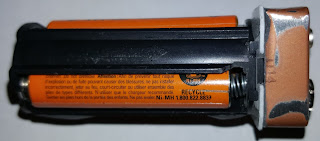I wrote a blog post a
while back showing my initial attempt to get rid of a 9V battery for my Minelab
Pro-Find 35. Since then, I’ve revised my design a few times. The revisions
weren’t to improve performance, but instead make it less cumbersome to use.
The purpose of this blog
post is to document and share some of these revisions, as well as show you the
final iteration. This final iteration still has room for improvement, but for
now, I think I’ll settle on its design.
First
Revision
I basically just took
the wiring and cleaned it up some so it was more compact and contained. I’ll
just let me pictures do the talking:
Second
Revision/Garrett Carrot
I later was able to pick
up a Garrett Carrot as a part of a Equinox 600 package deal I purchased. So I
decided to work on this battery conversion so it would work in that pinpointer.
I also wanted to do away with the lithium battery. This lithium battery, if not
properly maintained (stored with sufficient charge), would literally go bad
just sitting in storage.
Perhaps there was some
other maintenance I could have done to protect the lithium battery, but I
didn’t want a high maintenance battery. So I decided to start using
rechargeable NiMH AAA cells. Below are the pictures that show what I did.
The
Third Revision
This worked in both the
Garrett Carrot (Pro-Pointer AT) and Minelab Pro-Find 35.
The
Fourth Revision
I’ll begin by just
showing you the final set up. This is designed for the Garrett Carrot, although
it should work in the Pro-Find 35. I can’t confirm the latter as I recently
sold that pinpointer because I didn’t need two virtually identically performing
(for my purposes) pinpointers.
That last picture is just for
kicks. Maybe one day I’ll paint the battery endcap extension green and make the
Garrett Carrot look even more like a carrot.
This will run off of
alkaline, lithium AAA primaries (with about 1.7 nominal volts), NiCd or NiMH
cells. So basically, if you have a AAA cell, it’ll work with this adapter. I
primary use it with LSD NiMH cells. This adapter is also reverse compatible in
that if I wanted to use the Garrett Carrot with a regular 9V battery, I could.
All I would need is a special spacer (wad of paper, piece of foam, etc.) to
serve as a filler in the extended battery endcap.
And yes, watertight
integrity is maintained even with the battery endcap extension.
Drawbacks
Besides the obvious
change in form factor, there are only 2 drawbacks. First, there is the reduced
runtime. You can see my prior blog post for a discussion about it, but it’s not
a problem as this should easily last an entire day’s worth of hunting (I can
recharge at night).
The second drawback is
the biggest one (in my opinion). It’s the parasitic electrical draw that the 9V
booster chip pulls. Based on my testing, 3 fully charged AAA NiMH cells (about
800 mah of capacity per cell), will be completely dead (as far as the
pinpointer is concerned) in about 3 to 4 weeks.
So this is why there’s
that red wire and black plug on the side of the adapter. This serves as a switch.
I could actually install a switch, but I didn't have a small enough one on hand
and I didn’t feel like spending $5 in shipping for a 75 cent (or so) component.
But during my next order for electronic components, I'll add a small switch to
my order. When the red wire is disconnected, the batteries should last years in
storage (they’re Eneloops) and still be ready to go when the time comes. So
far, it’s lasted 7+ weeks without any noticeable parasitic power drain.
Now
What?
The first major step in
removing 9V batteries from my metal detecting gear is done. I’m currently
working on using a 4x AA cell rechargeable battery pack to replace the dual 9V
battery setup in my Fisher F2.

























